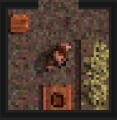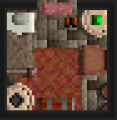Home: Difference between revisions
No edit summary |
Iamzeroone (talk | contribs) (Removal of privacy. Added it to trivia as past feature. Various gramatical changes. Removed mention of dormitory. Updated structure sizes. Added dedicated header for the Housing GUI, including an image, description of the GUI, further detail on each available tool, made adjustments to language for clarity, added info for the House Upgrader tool and included in-line image. Updated image of the Assign tool. Added table for home capacities. Added links where appropriate.) |
||
| Line 5: | Line 5: | ||
|icon = [[File:home_icon.png]] | |icon = [[File:home_icon.png]] | ||
|cost = None | |cost = None | ||
|building_type = [[ | |building_type = [[Civics]] | ||
|subtype = | |subtype = [[Housing]] | ||
|noise = No | |noise = No | ||
|components = 0 | |components = 0 | ||
| Line 13: | Line 13: | ||
|input = | |input = | ||
|output = | |output = | ||
}}A '''Home''' is the standard [[building]] where your non-[[nobles|noble]] subjects can take up residence. | }}A '''Home''' is the standard [[building]] where your non-[[nobles|noble]] subjects can take up residence. Under the build menu, it is found under [[Civics]] -> [[Housing]] -> House. The building provides a variable amount of housing depending on which variant you use. The residents can furnish the home in which they currently live, which consumes [[resources]] depending on how many you have allotted for use. There are no [[components]] to this building, and they come in 3 variants: Apartment, House, and Longhouse. All three variants are built by selecting '''House''' in the build menu. | ||
Apartments are | Apartments are 3×3 structures that provide housing for 1 subject. Houses are 3×5 structures that provide housing for 2 subjects. Longhouses are 5×6 structures that provide housing for 4 subjects. After upgrades, each variant will hold more subjects. | ||
Unlike almost every other building in the game, all variants of the home are fully walled by default, and thus do not need to have further [[walls]] built through structures. Subjects will take housing as close to their | Unlike almost every other building in the game, all variants of the home are fully walled by default, and thus do not need to have further [[walls]] built through structures. Subjects will take housing as close to their occupation as possible. Each residence may only contain one [[race]] at a time. | ||
Each race | Once a subject has a home, they can take resources to furnish it. Each race will have a different spread of resources that they can ration to fulfill this desire, from [[stone]] to [[gems]] and even [[livestock]]. Subjects will consume 1 resource when allotted, then 0.50 of each year in upkeep. Each resource used to furnish a home will also change the appearance of the interior, depending on what it is ([[fabric]] will give rugs, [[wood]]/stone will give flooring, etc.). | ||
Homes can further be interacted with by utilizing the Housing GUI. Subjects can be assigned specific housing, [[Odd jobber|odd jobbers]] can be moved and housing can be upgraded to hold more subjects. | |||
== | ==The Housing GUI== | ||
[[File:HousingGUI.png|alt=A screenshot of the Housing GUI.|left|thumb|The Housing GUI.]] | |||
{| | |||
|The Housing GUI can be viewed at any time by selecting the housing icon from the [[settlement]] status overview grid at the top left of the screen or by selecting any fully constructed home. Within this GUI, there are several tools available at the top. Those tools, from left to right: Assign, O-Mover, and the House Upgrader tool, as well a toggle for the housing overlay. | |||
Beneath the tools, a grid is displayed detailing the current housing status of all the subjects in your settlement, which includes nobility, citizens and [[slaves]]. Citizens and slaves are further broken down by race. | |||
Finally, assigned furniture totals are displayed at the bottom. The number displayed in each status bar is the currently used amount of that resource as furniture and are indicated by the green status bars. The red status bar is the unfulfilled amount of each resource. Gray furniture status bars indicate that no race in your settlement uses that resource as furniture. Hovering the mouse over any of these will display more detailed statistics, including that resource's annual consumption rate. | |||
Each home can have a separate restriction placed on it, and placing a different restriction on a home that currently has one will replace it immediately. To unrestrict a home you can use the anyone subject restriction. If the current residents of home do not meet the new restrictions they will lose their residence in that home. | '''''Note:''''' ''There is a difference between this type of furniture and the [[Carpenter|Carpenter's]] product [[furniture]]. A home can be furnished with a variety of resources and these resources are referred to as furniture. However, the Carpenter is capable of making a product that is also called furniture. This product has many uses, but it is also one of the resources that may be used in the furnishing of homes.'' | ||
|- | |||
| | |||
===Assign=== | |||
{{imagefix|[[File:assign_home_icon_sm.png|left]]}}This tool allows you to assign homes for the use of everyone, citizens only, a specific race of citizen, slaves only, or a specific race of slave. The top row lets you choose assignment by everyone, citizens, or slaves. The default assignment is everyone (the question mark icon). If you choose either citizen or slave, then the second row can be used to further restrict housing to all races of that class or to a single race of that class, but not more than one. This can be used to ensure that your citizens get the housing that may be best for them or to keep slaves in specific areas.[[File:AssignTool-v064.png|The Assign tool.|alt=Screenshot of the assign tool.|thumb]]Each home can have a separate restriction placed on it, and placing a different restriction on a home that currently has one will replace it immediately. To unrestrict a home you can use the anyone subject restriction. If the current residents of home do not meet the new restrictions they will lose their residence in that home. | |||
In-game tool tip: ''"Lets you assign homes to specific criteria."'' | |||
|- | |||
| | |||
===O-Mover === | |||
{{imagefix|[[File:odd_mover_icon.png|left]]}}The O-Mover (aka Odd Mover) is not a building, but a tool that you can use on homes. It allows you to move oddjobers from other homes into the ones you highlight with the tool. This can be used to remove oddjobers from good homes near industries, allowing the subjects who are employed to get the better housing. | |||
In-game tool tip: ''"Odd jobbers will automatically move out if an employed subject needs their home. This tool manually moves random oddjobbers to desired housing."'' | |||
|- | |||
| | |||
===House Upgrader=== | |||
{{imagefix|[[File:UpgradeHome.png|left]]}}This tool allows you to instantly upgrade homes to house more subjects. This is only available for use after unlocking Basements and Second Floors in the Technology Tree GUI. The resources used are not refundable. If the required resources are available, then the upgrade happens instantaneously. Workers do not need to do anything for the upgrade to take effect. | |||
In-game tool tip: ''"Instantly upgrades houses to accommodate more lodgers. Resources used are not refundable."'' | |||
|- | |||
|} | |||
==Housing Capacity== | |||
{| class="wikitable" style="width: 500px; text-align: center;" | |||
! | |||
!Apartment | |||
!House | |||
!Longhouse | |||
|- | |||
|Default | |||
|1 | |||
|2 | |||
|4 | |||
|- | |||
|Upgraded with Basement | |||
|2 | |||
|4 | |||
|7 | |||
|- | |||
|Upgraded with Second Floor | |||
|3 | |||
|5 | |||
|10 | |||
|} | |||
==In-game description== | ==In-game description== | ||
''"Essential service where your subjects sleep and spend much of their time. Comes in different sizes | ''"Essential service where your subjects sleep and spend much of their time. Comes in different sizes and can be upgraded to house even more subjects. Subjects can upgrade their homes with resources if you allow them."'' | ||
==Trivia== | ==Trivia== | ||
*Before version 0.64 of the game, different types of homes provided different levels of the privacy stat. Different [[race]]s prefered different levels of privacy in their homes. This stat has since been removed from the game. | |||
*Before version 0.62 of the game, both apartments and dormitories existed as a normal room type that could be customized. | *Before version 0.62 of the game, both apartments and dormitories existed as a normal room type that could be customized. | ||
*Housing used to be communal, with nobody being tied to a specific building. | *Housing used to be communal, with nobody being tied to a specific building. | ||
== Gallery == | ==Gallery== | ||
<gallery widths="170px"> | <gallery widths="170px"> | ||
File:Human_Apartment.png|An apartment with Human residents. | File:Human_Apartment.png|An apartment with Human residents. | ||
Revision as of 15:15, 11 September 2023
| Home | |
|---|---|
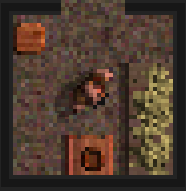
| |
| A humble abode for your loyal subjects. | |
| Building Information | |
| Icon | |
| Building cost | None |
| Category | Civics |
| Sub-category | Housing |
| Produces noise? | No |
| Components | 0 |
| Expandable? | No |
| Component Requirements | None |
| Production Information | |
| Input | None |
| Output | None |
A Home is the standard building where your non-noble subjects can take up residence. Under the build menu, it is found under Civics -> Housing -> House. The building provides a variable amount of housing depending on which variant you use. The residents can furnish the home in which they currently live, which consumes resources depending on how many you have allotted for use. There are no components to this building, and they come in 3 variants: Apartment, House, and Longhouse. All three variants are built by selecting House in the build menu.
Apartments are 3×3 structures that provide housing for 1 subject. Houses are 3×5 structures that provide housing for 2 subjects. Longhouses are 5×6 structures that provide housing for 4 subjects. After upgrades, each variant will hold more subjects.
Unlike almost every other building in the game, all variants of the home are fully walled by default, and thus do not need to have further walls built through structures. Subjects will take housing as close to their occupation as possible. Each residence may only contain one race at a time.
Once a subject has a home, they can take resources to furnish it. Each race will have a different spread of resources that they can ration to fulfill this desire, from stone to gems and even livestock. Subjects will consume 1 resource when allotted, then 0.50 of each year in upkeep. Each resource used to furnish a home will also change the appearance of the interior, depending on what it is (fabric will give rugs, wood/stone will give flooring, etc.).
Homes can further be interacted with by utilizing the Housing GUI. Subjects can be assigned specific housing, odd jobbers can be moved and housing can be upgraded to hold more subjects.
The Housing GUI
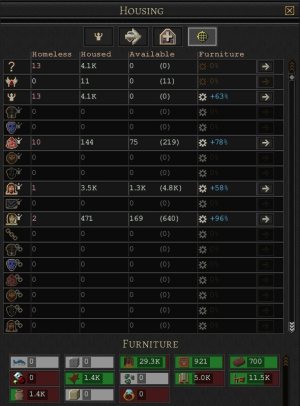
| The Housing GUI can be viewed at any time by selecting the housing icon from the settlement status overview grid at the top left of the screen or by selecting any fully constructed home. Within this GUI, there are several tools available at the top. Those tools, from left to right: Assign, O-Mover, and the House Upgrader tool, as well a toggle for the housing overlay.
Beneath the tools, a grid is displayed detailing the current housing status of all the subjects in your settlement, which includes nobility, citizens and slaves. Citizens and slaves are further broken down by race. Finally, assigned furniture totals are displayed at the bottom. The number displayed in each status bar is the currently used amount of that resource as furniture and are indicated by the green status bars. The red status bar is the unfulfilled amount of each resource. Gray furniture status bars indicate that no race in your settlement uses that resource as furniture. Hovering the mouse over any of these will display more detailed statistics, including that resource's annual consumption rate. Note: There is a difference between this type of furniture and the Carpenter's product furniture. A home can be furnished with a variety of resources and these resources are referred to as furniture. However, the Carpenter is capable of making a product that is also called furniture. This product has many uses, but it is also one of the resources that may be used in the furnishing of homes. |
AssignThis tool allows you to assign homes for the use of everyone, citizens only, a specific race of citizen, slaves only, or a specific race of slave. The top row lets you choose assignment by everyone, citizens, or slaves. The default assignment is everyone (the question mark icon). If you choose either citizen or slave, then the second row can be used to further restrict housing to all races of that class or to a single race of that class, but not more than one. This can be used to ensure that your citizens get the housing that may be best for them or to keep slaves in specific areas.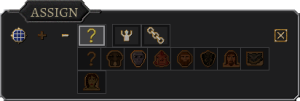 In-game tool tip: "Lets you assign homes to specific criteria." |
O-MoverThe O-Mover (aka Odd Mover) is not a building, but a tool that you can use on homes. It allows you to move oddjobers from other homes into the ones you highlight with the tool. This can be used to remove oddjobers from good homes near industries, allowing the subjects who are employed to get the better housing. In-game tool tip: "Odd jobbers will automatically move out if an employed subject needs their home. This tool manually moves random oddjobbers to desired housing." |
House UpgraderThis tool allows you to instantly upgrade homes to house more subjects. This is only available for use after unlocking Basements and Second Floors in the Technology Tree GUI. The resources used are not refundable. If the required resources are available, then the upgrade happens instantaneously. Workers do not need to do anything for the upgrade to take effect. In-game tool tip: "Instantly upgrades houses to accommodate more lodgers. Resources used are not refundable." |
Housing Capacity
| Apartment | House | Longhouse | |
|---|---|---|---|
| Default | 1 | 2 | 4 |
| Upgraded with Basement | 2 | 4 | 7 |
| Upgraded with Second Floor | 3 | 5 | 10 |
In-game description
"Essential service where your subjects sleep and spend much of their time. Comes in different sizes and can be upgraded to house even more subjects. Subjects can upgrade their homes with resources if you allow them."
Trivia
- Before version 0.64 of the game, different types of homes provided different levels of the privacy stat. Different races prefered different levels of privacy in their homes. This stat has since been removed from the game.
- Before version 0.62 of the game, both apartments and dormitories existed as a normal room type that could be customized.
- Housing used to be communal, with nobody being tied to a specific building.
Gallery
-
An apartment with Human residents.
-
A longhouse with Garthimi residents.
-
A fully furnished apartment with Dondorian residents.
-
Many line-ups of many homes.



